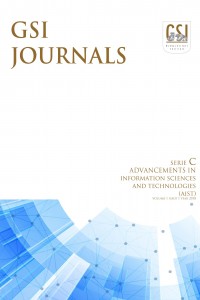Öz
Kaynakça
- Canbey-Özgüler, V. (2007). Knowledge workers of future: the children, are falling into the digital divide. International Symposium on The Changes and Transformations in The Socio-Economic and Political Structure of Turkey Within The EU Negotiations, 16-18 March 2006 Kütahya.
- Canbey-Özgüler, V.& Aşan, Z. (2007). Kadınların bilişim iletişim teknolojileri (BİT) kullanımı: Türkiye örneği, Cahit Talas Anısına Güncel Sosyal Politika Tartışmaları, Ankara: Ankara Üniversitesi Siyasal Bilgiler Fakültesi Ya. No. 595, s.213-247.
- ITU (2011). ITU (International Telecommunication Union), Retrieved from http://www.itu.int/ITU-D/ict/statistics/material/pdf, (Accessed on 08.08.2012).
- ITU (2015). Facts and figures. Retrieved from http://www.itu.int/en/ITU-D/Statistics/Documents/facts/ICTFactsFigures2015.pdf, (Accessed on 27.06.2016).
- Norris, P. (?). Digital divide. Retrieved from http://ksghome.harvard.edu/pnorris/Books/Digital%20Divide.htm, (Accessed on 09.02.2006).
- Schwab, K. (2016). Dördüncü Sanayi Devrimi, (Z. Dicleli, Çev.). İstanbul: Optimist Yayım Dağıtım San. Ve Tic. Ltd. Şti.
- Umayahara, M. (2014). Benefits and risks of ICT Use in Early Childhood, Retrieved from http://www.unescobkk.org/education/ict/online-resources/databases/ict-in-education-database/item/article/benefits-and-risks-of-ict-use-in-early-childhood/, (Accessed on 27.06.2016).
- http://www.itu.int/en/ITU-D/Statistics/Pages/publications/default.aspx, (Accessed on 27.06.2016).
- http://wearesocial.com, (Accessed on 10.03.2018).
- https://www.childtrends.org/indicators/home-computer-access, (Accessed on 17.01.2018).
- http://www.internetstats.com, (Accessed on 12.04.2018).
- http://www.itu.int/, (Accessed on 17.01.2018).
- https://data.worldbank.org/indicator/SP.POP.0014.TO.ZS, (Accessed on 07.04.2018).
- http://www.techaddiction.ca/media-statistics.html, (Accessed on 17.01.2018).
- http://www.tuik.gov.tr/HbGetirHTML.do?id=27587, (Accessed on 11.01.2018).
- http://www.tuik.gov.tr/PreHaberBultenleri.do?id=15866, (Accessed on 23.05.2018)..
- http://www.worldometers.com, (Accessed on 02.01.2018)
Öz
Information communication technologies (ICT) have
launched a new era of “non-industrial” communities. Today, ICT is recognized to
greatly influence the primary, secondary, and tertiary sectors of the economy, that
is, agriculture, industry, and services, respectively. Education affects every
dimension of social life with the increasing number of new applications such as
intelligent robots, big data, cloud services, Internet of things, artificial
neural networks, and 3D printing[1]. In this context, every
part of society must use these technologies effectively. Unfortunately, there
are inequalities in the use and ownership of ICT. The concept of digital divide
refers to the gap between ICT owners and non-ICT owners. ICT can reshape the global
economy. An important problem in this regard is to develop skilled man power
that will be able to use and adopt these technologies and develop new ones.
This study analyses ICT use by children, who will be knowledge workers of the
future, by using current reports and data.
[1] The form of production that is shaped by these
technologies is now called Industry 4.0 (Schwab, 2016: 24).
Anahtar Kelimeler
Information Communication Technologies (ICT) Digital Divide Information Society
Kaynakça
- Canbey-Özgüler, V. (2007). Knowledge workers of future: the children, are falling into the digital divide. International Symposium on The Changes and Transformations in The Socio-Economic and Political Structure of Turkey Within The EU Negotiations, 16-18 March 2006 Kütahya.
- Canbey-Özgüler, V.& Aşan, Z. (2007). Kadınların bilişim iletişim teknolojileri (BİT) kullanımı: Türkiye örneği, Cahit Talas Anısına Güncel Sosyal Politika Tartışmaları, Ankara: Ankara Üniversitesi Siyasal Bilgiler Fakültesi Ya. No. 595, s.213-247.
- ITU (2011). ITU (International Telecommunication Union), Retrieved from http://www.itu.int/ITU-D/ict/statistics/material/pdf, (Accessed on 08.08.2012).
- ITU (2015). Facts and figures. Retrieved from http://www.itu.int/en/ITU-D/Statistics/Documents/facts/ICTFactsFigures2015.pdf, (Accessed on 27.06.2016).
- Norris, P. (?). Digital divide. Retrieved from http://ksghome.harvard.edu/pnorris/Books/Digital%20Divide.htm, (Accessed on 09.02.2006).
- Schwab, K. (2016). Dördüncü Sanayi Devrimi, (Z. Dicleli, Çev.). İstanbul: Optimist Yayım Dağıtım San. Ve Tic. Ltd. Şti.
- Umayahara, M. (2014). Benefits and risks of ICT Use in Early Childhood, Retrieved from http://www.unescobkk.org/education/ict/online-resources/databases/ict-in-education-database/item/article/benefits-and-risks-of-ict-use-in-early-childhood/, (Accessed on 27.06.2016).
- http://www.itu.int/en/ITU-D/Statistics/Pages/publications/default.aspx, (Accessed on 27.06.2016).
- http://wearesocial.com, (Accessed on 10.03.2018).
- https://www.childtrends.org/indicators/home-computer-access, (Accessed on 17.01.2018).
- http://www.internetstats.com, (Accessed on 12.04.2018).
- http://www.itu.int/, (Accessed on 17.01.2018).
- https://data.worldbank.org/indicator/SP.POP.0014.TO.ZS, (Accessed on 07.04.2018).
- http://www.techaddiction.ca/media-statistics.html, (Accessed on 17.01.2018).
- http://www.tuik.gov.tr/HbGetirHTML.do?id=27587, (Accessed on 11.01.2018).
- http://www.tuik.gov.tr/PreHaberBultenleri.do?id=15866, (Accessed on 23.05.2018)..
- http://www.worldometers.com, (Accessed on 02.01.2018)
Ayrıntılar
| Birincil Dil | İngilizce |
|---|---|
| Konular | Matematik |
| Bölüm | Articles |
| Yazarlar | |
| Yayımlanma Tarihi | 25 Temmuz 2018 |
| Yayımlandığı Sayı | Yıl 2018 Cilt: 1 Sayı: 1 |

